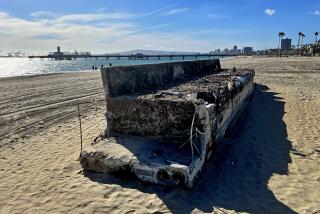Volunteers scour Long Beach shoreline for tar balls
The volunteers stood several feet apart, like a police line on the sand.
Members of the Community Emergency Response Team, they were armed Thursday morning in green vests, green helmets and goggles making a sweep of the Long Beach shoreline, looking for a sticky culprit that had invaded the night before: tar balls.
“Eagle eye,” Lynne Wainfan, a volunteer, said when she spotted one. She placed a small yellow flag on it to alert the cleaning crews and continued scanning the sand, quickly finding several of the hard little pieces of tar.
“I’m going to run out of flags,” she said as she kept finding them.
Such was the scene on the closed shores of Long Beach as crews cleaned up the tar balls that were found scattered on the sand Wednesday. Four miles of coastline were closed Thursday to eliminate potential hazards to the public, Long Beach city officials said.
The U.S. Coast Guard collected samples of the tar balls to determine the source of the blobs. There was no immediate indication that the tar balls came from operations by the Long Beach Gas and Oil Department, Long Beach officials said.
Laboratory testing will help investigators determine whether the tar traveled from Santa Barbara County, where a May 19 oil spill released as much as 101,000 gallons of crude. An estimated 21,000 gallons of oil spewed into the Pacific Ocean.
As the Community Emergency Response Team volunteers continued to walk the beach, they questioned what to name their mission.
“What do we call this?” Wainfan, 57, of Long Beach asked another volunteer.
“It’s an unknown incident at this time,” another volunteer said, chuckling.
“Do we even call it an oil spill?” Wainfan asked.
“It’s some kind of petroleum substance,” one volunteer responded. The group laughed.
Ahead of the volunteers, three women looked down at the sand, using their shoes to nudge something.
Ruth Funk, of Los Alamitos, had brought her daughter and a friend from Utah to the beach to search for sea shells. Instead, they found tar balls.
Funk, a substitute teacher who tries to come to the beach several times a week, said she’d seen tar on the beach before and wasn’t too taken aback. She said this week’s tar balls washed up on a section of the beach that wasn’t the most popular spot to swim in.
“It’s dirty,” Funk said, adding that she’d seen dead seals, a dead chicken and other trash wash up on the shore before. “But it doesn’t deter me from coming down here. There are good things to be found here.”
In recent days, tar balls have washed ashore in Ventura County, Malibu and the South Bay, where a nearly eight-mile section of the beach was closed for three days last week.
Coast Guard officials said last week that results from samples taken from the tar ball appearances in the South Bay could take weeks. They said scientists from the National Oceanic and Atmospheric Administration were trying to determine if, given existing weather patterns, it was possible for oil to travel from Santa Barbara to the South Bay.
According to the NOAA, tar balls are remnants of oil spills that occur when crude floats on the ocean surface, changing its physical composition in processes known as “weathering.” After an oil spill or natural seepage from fissures in the ocean floor, waves and wind break up the slick into small patches, or tar balls, that scatter into the ocean.
Tar balls can travel hundreds of miles.
Long Beach city officials have advised people to stay away from beaches, cautioning that the tar may irritate skin or cause long-term health effects.
On Thursday, Long Beach Animal Control officials said they had not discovered any animals affected by the tar.
Los Angeles Times staff writer Hailey Branson-Potts contributed to this report.
For breaking news in California, follow @LATvives, @VeronicaRochaLA and @MattHjourno on Twitter.
More to Read
Start your day right
Sign up for Essential California for news, features and recommendations from the L.A. Times and beyond in your inbox six days a week.
You may occasionally receive promotional content from the Los Angeles Times.








